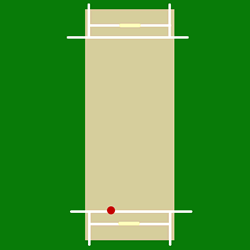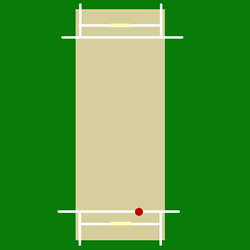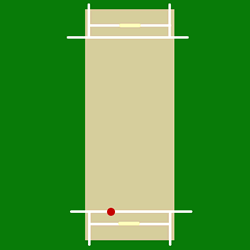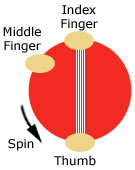Related Research Articles

Leg spin is a type of spin bowling in cricket. A leg spinner bowls right-arm with a wrist spin action. The leg spinner's normal delivery causes the ball to spin from right to left when the ball bounces on the pitch. For a right-handed batter, that is away from the leg side, and this is where it gets the name leg break.

Left-arm orthodox spin or left-arm off spin, also known as slow left-arm orthodox spin bowling, is a type of left-arm finger spin bowling in the sport of cricket. Left-arm orthodox spin is bowled by a left-arm bowler using the fingers to spin the ball from right to left of the cricket pitch.

Left-arm unorthodox spin, also known as slow left-arm wrist spin, is a type of spin bowling in the sport of cricket. Left-arm unorthodox spin bowlers use wrist spin to spin the ball, and make it deviate, or 'turn' from left to right after pitching. The direction of turn is the same as that of a traditional right-handed off spin bowler, although the ball will usually turn more sharply due to the spin being imparted predominantly by the wrist.
The flipper is a particular bowling delivery used in cricket, generally by a leg spin bowler. In essence it is a back spin ball. Squeezed out of the front of the hand with the thumb and first and second fingers, it keeps deceptively low after pitching and can accordingly be very difficult to play. The flipper is comparable to a riseball in fast-pitch softball.

Off spin is a type of finger spin bowling in cricket. A bowler who uses this technique is called an off spinner. Off spinners are right-handed spin bowlers who use their fingers to spin the ball. Their normal delivery is an off break, which spins from left to right when the ball bounces on the pitch. For a right-handed batsman, this is from his off side to the leg side. The ball breaks away from the off side, hence the name 'off break'.
In the game of cricket, a googly refers to a type of delivery bowled by a right-arm leg spin bowler. It is different from the normal delivery for a leg-spin bowler in that it is turning the other way. The googly is not a variation of the typical off spin type of delivery, in that the cricket ball is presented from the bowler's hand in such a way that once the ball pitches; instead, it deviates in the opposite direction of a leg spinning type of delivery. It has also been colloquially referred to as the wrong'un, Bosie or Bosey, with the latter two eponyms referring to Bernard Bosanquet, the bowler who originally devised and began using the googly.
A topspinner is a type of delivery bowled by a cricketer bowling either wrist spin or finger spin. In either case, the bowler imparts the ball with top spin by twisting it with his or her fingers prior to delivery. In both cases, the topspinner is the halfway house between the stock delivery and the wrong'un - in the wrist spinner's case his googly, and in the finger spinner's case his doosra.

Saqlain Mushtaq is a Pakistani cricket coach and former international cricketer who was the head coach of the Pakistani national cricket team between 2021 and 2022. He is best known for pioneering the "doosra", a leg break delivery bowled with an off break action. He was the fastest to reach the milestones of 200 and 250 wickets in ODIs. Mushtaq made history when he became the first Pakistani to take a hat-trick at a Cricket World Cup, which he did against Zimbabwe during the 1999 tournament.
A doosra is a particular type of delivery by an off-spin bowler in cricket. The doosra spins in the opposite direction to an off break, and aims to confuse the batsman into playing an unavoidable shot.

Spin bowling is a bowling technique in cricket, in which the ball is delivered relatively slowly but with the potential to deviate sharply after bouncing. The bowler is referred to as a spinner.
An arm ball is a type of delivery in cricket. It is a variation delivery bowled by an off spin bowler or slow left-arm orthodox bowler. It is the finger spin equivalent of a wrist spinner's slider or zooter.

An off cutter is a type of delivery in the game of cricket. It is bowled by fast bowlers.
In the sport of cricket there are two broad categories of bowlers: pace and spin. Pace bowlers rely mostly on the speed of the ball to dismiss batsmen, whereas spin bowlers rely on the rotation and turn of the ball.
In the sport of cricket, a slower ball is a slower-than-usual delivery from a fast bowler. The bowler's intention is to deceive the batsman into playing too early so that he either misses the ball completely or hits it high up in the air to offer an easy catch. It is analogous to a changeup in baseball.

A delivery or ball in cricket is a single action of bowling a cricket ball toward the batter. Once the ball has been delivered, batters may attempt to score runs, with the bowler and other fielders attempting to stop this by getting the batters out. When the ball becomes dead, the next delivery can begin.
Wrist spin is a type of bowling in the sport of cricket. It refers to the cricket technique and specific hand movements associated with imparting a particular direction of spin to the cricket ball. The other spinning technique, usually used to spin the ball in the opposite direction, is finger spin. Wrist spin is bowled by releasing the ball from the back of the hand, so that it passes over the little finger. Done by a right-handed bowler, this imparts an anticlockwise rotation to the ball, as seen from the bowler's perspective; a left-handed wrist spinner rotates the ball clockwise.
Finger spin is a type of bowling in the sport of cricket. It refers to the cricket technique and specific hand movements associated with imparting a particular direction of spin to the cricket ball. The other spinning technique, generally used to spin the ball in the opposite direction, is wrist spin. Although there are exceptions, finger spinners generally turn the ball less than wrist spinners. However, because the technique is simpler and easier to master, finger spinners tend to be more accurate.
Throwing, commonly referred to as chucking, is an illegal bowling action in the sport of cricket. This occurs when a bowler straightens the bowling arm when delivering the ball. Throws are not allowed when a bowler bowls to a batsman. If the umpire deems that the ball has been thrown, they will call a no-ball, which means the batsman cannot be given out from that delivery.
In cricket, a slider is a type of delivery bowled by a wrist spin bowler. While a topspinner is released with the thumb facing the batter, a slider is bowled in a similar manner to a legbreak, but instead of imparting sidespin with the third finger, the bowler allows his fingers to roll down the back of the ball, providing a mixture of sidespin and backspin. Whereas a topspinner tends to dip more quickly and bounce higher than a normal delivery, a slider does the opposite: it carries to a fuller length and bounces less than the batter might expect. The sliders will typically head towards the batter with a scrambled seam. This has less effect on the flight and bounce but absence of leg spin may deceive the batter. Frequently the slider is bowled with a mixture of side spin and backspin. This has the effect of making the ball harder to differentiate from the leg break for the batters without reducing the mechanical effects caused by the backspin. This delivery may skid straight on or it may turn a small amount.

Saeed Ajmal SI is a Pakistani cricket coach and former cricketer, who played all forms of the game. He is a right-arm off-spin bowler who bats right handed. At domestic level in Pakistan he represented Faisalabad, with whom he won the 2005 ABN-AMRO Twenty-20 Cup; Khan Research Laboratories; and Islamabad. Ajmal made his One Day International debut for Pakistan in July 2008 at the age of 30, and a year later played his first Test. In 2009, he was reported for having a suspect bowling action, but after being cleared he helped Pakistan win the 2009 ICC World Twenty20. Ajmal played for Worcestershire as an overseas player in English domestic cricket in 2011. From November 2011 to December 2014, Ajmal was ranked by the International Cricket Council as the number one bowler in ODIs. He reached the same ranking in T20Is between October and December 2012, while his highest Test ranking was second between January and July of the same year. He is one of four Test bowlers that made their debut after the age of thirty to take more than 100 test wickets, along with Clarrie Grimmett, Dilip Doshi and Ryan Harris.
References
- ↑ [Brian Wilkins "The Bowler's Art"]
- ↑ Arnold adjudged Plumb to miraculous Teesra by Saqi
- ↑ "Ajmal's ten, and Misbah's impressive start to captaincy" . Retrieved 21 January 2012.